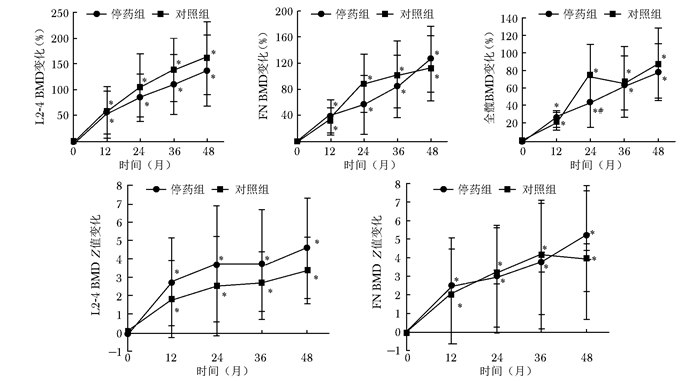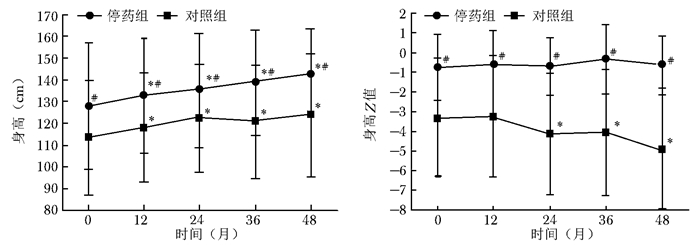成骨不全症(osteogenesis imperfecta, OI)是以骨脆性增加、反复骨折、骨骼畸形为特征的单基因遗传病,可有蓝巩膜、听力障碍、牙本质发育不全、韧带松弛等骨外表现[1-2]。OI患者临床表型轻重不等,基于基因型和临床表型,可分为5型:Ⅰ型为轻型,Ⅱ型为围生期致死型,Ⅲ型为存活患者中最严重的类型,Ⅳ型严重度介于Ⅰ型和Ⅲ型之间,Ⅴ型具有前臂骨间膜钙化、桡骨小头脱位等特殊表现[3-5]。OI由于引发反复骨折、进行性骨畸形,严重影响患者生活质量,也给家庭和社会带来沉重经济负担,然而,目前尚无针对其病因的有效治疗方法。
双膦酸盐(bisphosphonates, BPs)类药物目前广泛应用于治疗儿童及成人OI,通过与骨骼羟基磷灰石的高亲和力,能特异性结合于骨矿盐表面,影响破骨细胞微骨架和皱褶缘的形成,抑制其释放酸性物质及酶类,减少骨吸收、增加骨密度(bone mineral density,BMD)[6-8]。然而,BPs对不同临床表型的OI患者,药物疗程是否存在差异,尚不清楚[9-11]。为此,本研究对BPs治疗后BMD达正常而进入药物假期的OI患者,以及治疗时间相同、年龄性别匹配、因BMD仍低而继续治疗的OI患者,进行回顾性对比分析,比较两组基线及进入药物假期时的临床特点、药物疗效的差异,以探讨不同病情OI患者接受BPs治疗的适宜疗程。
对象与方法 对象从2004年1月至2015年12月于北京协和医院内分泌科门诊确诊并规律接受口服或静脉BPs治疗的OI患者中,选取治疗后BMD达同性别正常成人范围而进入药物假期的35例患儿归入停药组,平均年龄(9.1±4.6)岁;以同期年龄、性别、药物疗程匹配,BMD仍低,需要继续接受BPs治疗的35例OI患者为对照组,平均年龄(9.1±4.5)岁。入组标准:年龄<18岁;符合OI诊断标准。
OI诊断标准:(1)从小发病,≥1次非暴力性骨折;(2)BMD Z评分<-2.0;(3)骨骼X线片示长骨纤细、皮质菲薄;(4)伴或不伴蓝巩膜、听力异常、关节韧带松弛、牙本质异常;(5)伴或不伴头颅缝间骨、骨骼畸形[2]。OI分型标准:主要参照2015年国际骨骼发育异常协会(International Skeletal Dysplasia Society)制定的OI分型标准,结合患者病情严重程度分为Ⅰ、Ⅲ、Ⅳ型[3-5]。停药标准[12]:腰椎及全髋BMD达到正常成人BMD,即腰椎:男性1.002 g/cm2,女性0.956 g/cm2;全髋:男性0.966 g/cm2,女性0.874 g/cm2。
方法记录患者治疗0、1、2、3、4年及停药时骨转换生化指标、BMD,评估治疗前骨折率及治疗期间新发骨折率,记录患者年龄、身高、体质量,计算体质量指数(body mass index, BMI)。
药物治疗:唑来膦酸(密固达,诺华制药公司,瑞士),每年1次,每次输注5 mg,静脉输注至少15 min;阿仑膦酸钠(福美加,默沙东制药公司,美国),每周服用1次,每次70 mg,空腹用至少250 mL白水送服,服药后30 min避免平卧及进食。停药组有13、8、14例分别接受唑来膦酸、阿仑膦酸钠或两药序贯治疗;对照组有11、11、13例分别接受唑来膦酸、阿仑膦酸钠或两药序贯治疗。
骨生化指标检测:采用自动分析仪检测血钙、血磷、骨形成指标碱性磷酸酶(alkaline phosph-atase,ALP)浓度;采用化学发光法测定血清25羟维生素D(25 hydroxy vitamin D,25OHD)及骨吸收指标Ⅰ型胶原羧基端交联肽(β-cross linked C-telopeptide of type 1 collagen,β-CTX)浓度。
BMD测量:采用双能X线吸收检测法(dual energy X-ray absorptiometry,DXA)(Lunar, GE Healthcare, 美国)测量腰椎(lumbar 2-4, L2-4)、股骨颈(femoral neck, FN)、全髋(total hip, TH)BMD。
统计学方法根据中国和亚洲正常儿童BMD值计算年龄、性别校正后Z值[13]。因缺乏亚洲儿童及青少年正常全髋BMD参考值,本文未计算全髋BMD Z值。采用SPSS 20.0软件进行统计分析。计量资料以均数±标准差(x±s)表示,计数资料以百分率(%)表示,每组治疗前后数据,采用配对样本t检验或Wilcoxon检验;两组间比较,采用独立样本t检验或χ2检验。以P<0.05为差异有统计学意义。
结果 两组基线资料比较根据患者病情轻重,停药组Ⅰ型、Ⅲ型、Ⅳ型患者分别为33(94.3%)、0(0%)、2(5.7%)例,对照组分别为11(31.4%)、7(20.0%)、17(48.6%)例,两组构成比差异有统计学意义(P均<0.05),对照组病情较重的Ⅲ型、Ⅳ型患者所占比例更大;停药组临床表现较轻,其骨骼畸形、牙本质发育不良、头颅缝间骨和椎体压缩性骨折的发生率显著低于对照组;停药组身高Z值(-0.8±1.7)显著高于对照组(-3.3±3.0)(P<0.01)。停药组治疗前年骨折次数(1.3±2.6)少于对照组(2.1±3.5)(P<0.05)(表 1)。
| 组别 | 年龄(岁) | 性别(男:女) | 身高(cm) | 身高Z值 | 体质量(kg) | 体质量Z值 | BMI(kg/m2) | 治疗前骨折次数(次/年) | |
| 对照组(n=35) | 9.1±4.5 | 23:12 | 114.1±26.3 | -3.3±3.0 | 26.5±14.1 | -0.7±1.1 | 19.2±4.3 | 2.1±3.5 | |
| 停药组(n=35) | 9.1±4.6 | 23:12 | 128.0±29.1* | -0.8±1.7** | 34.4±17.1* | 0.3±1.0** | 19.5±4.2 | 1.3±2.6* | |
| 组别 | Sillence 分型 | 治疗药物 | 骨骼畸形 | 关节过伸 | |||||
| Ⅰ型 | Ⅲ型 | Ⅳ型 | 阿仑膦酸钠 | 唑来膦酸 | BPs序贯治疗 | ||||
| 对照组(n=35) | 11/35(31.4) | 7/35(20.0) | 17/35(48.6) | 11 | 11 | 13 | 22/35 (62.9) | 22/35 (62.9) | |
| 停药组(n=35) | 33/35(94.3)* | 0/35(0)* | 2/35(5.7)* | 8 | 13 | 14 | 9/35 (25.7)** | 21/35 (60.0) | |
| 组别 | 蓝巩膜 | 听力异常 | 牙本质异常 | 长骨皮质菲薄 | 缝间骨 | 胸腰椎骨折 | |||
| 对照组(n=35) | 28/34(82.4) | 1/32(3.1) | 15/32(46.9) | 30/31(96.8) | 32/34(94.1) | 18/34(52.9) | |||
| 停药组(n=35) | 29/35(82.9) | 1/33(3.0) | 7/33(21.2)* | 27/32(84.4) | 21/33(63.6)* | 7/27(25.9)* | |||
| BMI:体质量指数;BPs:双膦酸盐;与对照组相比,*P<0.05,**P<0.01 | |||||||||
停药组L2-4、FN、TH BMD高于对照组,L2-4、FN BMD Z值(-1.5±2.6、-2.5±2.4)显著高于对照组(-2.9±2.1、-5.2±2.9);两组患者血清ALP、β-CTX、25OHD水平差异无统计学意义(表 2)。
| 组别 | L2-4 BMD(mg/cm2) | L2-4 BMDZ值 | FN BMD(mg/cm2) | FN BMDZ值 | TH BMD(mg/cm2) | Ca(mmol/L) |
| 对照组(n=35) | 419±182 | -2.9±2.1 | 300±231 | -5.2±2.9 | 328±226 | 2.5±0.2 |
| 停药组(n=35) | 543±229* | -1.5±2.6* | 513±241** | -2.5±2.4** | 573±216** | 2.5±0.1 |
| 组别 | P(mmol/L) | ALP(U/L) | β-CTX(μg/L) | 25OHD(μg/L) | ALT(U/L) | Cr(μmol/L) |
| 对照组(n=35) | 1.9±0.7 | 259±153 | 0.8±0.3 | 19.1±7.9 | 17.0±13.0 | 41.8±10.5 |
| 停药组(n=35) | 1.7±0.2 | 302±134 | 0.8±0.3 | 18.2±6.2 | 25.9±23.0 | 44.5±13.2 |
| BMD:骨密度;L2-4:腰椎2-4;FN:股骨颈;TH:全髋;Ca:钙;P:磷;ALP:碱性磷酸酶;β-CTX:Ⅰ型胶原羧基端交联肽; 25OHD:25羟维生素D;ALT:丙氨酸氨基转移酶;Cr:肌酐;与对照组相比,*P<0.05,**P<0.01 | ||||||
经过平均4年双膦酸盐治疗,停药组BMD达正常水平,因而进入药物假期。4年治疗期间,两组各部位BMD较基线均明显升高,停药组及对照组腰椎BMD分别增加138.0%及161.4%,股骨颈BMD分别增加126.7%和113.5%,全髋BMD分别增加79.1%及87.1%,除治疗2年时对照组全髋BMD变化率高于停药组(P=0.010),BMD升高率组间差异无统计学意义(P均>0.05);两组L2-4、FN BMD Z值也逐年上升,两组间差异无统计学意义(P均>0.05)(图 1);两组血清β-CTX及ALP水平较基线明显下降,组间下降率差异无统计学意义(P均>0.05,图 2);停药组身高逐年增加,但身高Z值与基线相比无增加,对照组治疗期间身高有所增加,而身高Z值下降(图 3)。

|
| 图 1 两组骨密度及其Z值变化 Figure 1 Changes in BMD and Z-score between drug-discontinuation group and control group BMD:骨密度;L2-4:腰椎2-4;FN:股骨颈;与基线相比,*P<0.05;与对照组相比,#P<0.05 |

|
| 图 2 两组治疗48个月骨转换生化指标变化率比较 Figure 2 Comparison of percentage changes in bone turnover markers between two groups during 48 months of treatment β-CTX:Ⅰ型胶原羧基端交联肽;ALP:碱性磷酸酶;与基线相比,*P<0.05 |

|
| 图 3 两组身高及其Z值变化 Figure 3 Changes in body height and Z score in two groups 与基线相比,*P<0.05;与对照组相比,#P<0.05 |
停药组进入药物假期时,L2-4、FN、TH BMD分别为(1 065±129) mg/cm2、(944±92) mg/cm2、(941±92) mg/cm2,明显高于对照组(803±170) mg/cm2、(674±140) mg/cm2、(687±140) mg/cm2(P均<0.01);L2-4、FN BMD Z值(2.5±1.8、1.2±1.7)高于对照组(0.2±1.7、-1.4±2.0)(P均<0.01)(表 3)。另外,两组患者在治疗期间新发年骨折次数、β-CTX及ALP降低率差异均无统计学意义(P均>0.05)。
| 项目 | 对照组(n=35) | 停药组(n=35) |
| 身高(cm) | 131.1±22.2 | 151.3±19.3** |
| 身高Z值 | -3.6±3.1 | -0.5±1.2** |
| 体质量(kg) | 36.8±15.4 | 49.5±17.9** |
| 体质量Z值 | -1.0±1.4 | 0.5±1.5** |
| BMI(kg/m2) | 20.7±5.1 | 20.8±4.5 |
| 治疗期间新发骨折次数(次/年) | 0.4±0.7 | 0.2±0.2 |
| L2-4 BMD(mg/cm2) | 803±170 | 1 065±129** |
| L2-4 BMD Z值 | 0.2±1.7 | 2.5±1.8** |
| FN BMD(mg/cm2) | 674±140 | 944±92** |
| FN BMD Z值 | -1.4±2.0 | 1.2±1.7** |
| TH BMD(mg/cm2) | 687±140 | 941±92** |
| Ca(mmol/L) | 2.4±0.1 | 2.4±0.1 |
| P(mmol/L) | 1.5±0.2 | 1.4±0.2 |
| ALP(U/L) | 174±82 | 179±81 |
| β-CTX(ug/L) | 0.5±0.3 | 0.6±0.4 |
| 25OHD(ug/L) | 20.3±7.0 | 23.1±6.1 |
| ALT(U/L) | 19.5±10.3 | 20.3±13.7 |
| Cr(μmol/L) | 43.3±13.0 | 53.8±14.8 |
| BMI:体质量指数;BMD:骨密度;L2-4:腰椎2-4;FN:股骨颈;TH:全髋;Ca:钙;P:磷;ALP:碱性磷酸酶;β-CTX:Ⅰ型胶原羧基端交联肽; 25OHD:25羟维生素D;ALT:丙氨酸氨基转移酶;Cr:肌酐;与对照组比较,*P<0.05, **P<0.01 | ||
本研究显示BPs治疗能够有效增加OI患者BMD,减少新发骨折,降低骨转换率。停药组平均治疗4年BMD达正常而进入药物假期,该组患者临床表型相对较轻,Ⅰ型占比较高;对照组患者临床表型较重,主要为Ⅲ/Ⅳ型,患者需要接受更长期的BPs治疗。
双膦酸盐类药物是目前治疗OI的主要药物。在大样本OI患儿中,BPs可降低骨转换生化指标、增加BMD、改善骨微结构[14-15]。然而,BPs治疗OI的长期有效性和安全性尚不清楚。目前小样本研究报道帕米膦酸钠治疗OI最长时间为13.5年,其中11.5年为标准剂量,此后2年为低剂量维持,治疗期间患者全髋或腰椎BMD Z值维持于-0.5以上,骨转换持续抑制,骨折率明显降低,提示帕米膦酸钠对OI患儿长期治疗安全有效[16]。有研究对79例OI患儿予帕米膦酸钠长期治疗,平均疗程10.4年,治疗前4年患者BMD显著增加,骨折率持续下降;治疗结束时,BMD仍然明显高于基线,骨折率处于较低水平[10]。本组曾采用阿仑膦酸钠治疗相对大样本的OI患儿3年,结果发现,阿仑膦酸钠治疗使患者BMD增加、骨折率明显降低,且安全性好[17]。但是,随着对OI自然病程的认识,对BPs药理作用的深入研究,以及长期BPs治疗可能引起非典型骨折及下颌骨坏死等不良反应的报道,OI患者长期接受BPs治疗的利弊值得探讨[18-19]。本研究纳入70例OI儿童,BPs平均治疗时间长达4年(1~8年),患者腰椎、股骨颈及全髋BMD均显著增加,骨折率明显降低,未见非典型骨折等不良反应,提示阿仑膦酸钠、唑来膦酸或二者序贯治疗4年对OI患者安全有效。
关于BPs治疗OI患者的停药时机,存在争议[20-21]。Trejo等[22]建议,对于OI儿童,给予静脉输注唑来膦酸每6个月0.05 mg/kg治疗,当患者达到终身高时,停用BPs;若身高仍在增长,当腰椎BMD Z值增加至>-2.0时,唑来膦酸减量至每6个月0.025 mg/kg,当腰椎BMD Z值增至>0时,则给予唑来膦酸每年0.025 mg/kg低剂量维持治疗,直至患者生长停止。但也有研究者认为,BPs治疗第1年BMD增加最明显,最佳疗程为2~4年,此后BMD达平台期,可进入药物假期[9]。本研究综合考虑患者BMD获益,在BMD达同性别正常成人BMD值后予以停药。本研究停药组94.3%的患者为Ⅰ型,即轻型OI,而对照组绝大多数为病情较重的Ⅲ型与Ⅳ型OI,停药组基线BMD较高,骨折率低,骨骼畸形、牙本质发育不全也明显低于对照组,表明临床表型较轻的OI患者有望于平均治疗4年BMD正常,可考虑停药观察,而病情较重的OI患者则需要接受更长时间的治疗。
由此可见,双膦酸盐类药物可有效降低不同病情OI患者的新发骨折率、抑制骨转换率、增加BMD及其Z值。对于病情较轻的OI患者,双膦酸盐类药物平均治疗4年,BMD有望达正常水平,可考虑停药观察,而对于病情较重的OI患者,可能需要双膦酸盐类药物治疗更长的时间。本研究为成骨不全症患者接受个体化的双膦酸盐类药物治疗,提供了有益的临床研究基础。
| [1] | Forlino A, Marini JC. Osteogenesis imperfecta[J]. Lancet, 2016, 387: 1657–1671. DOI:10.1016/S0140-6736(15)00728-X |
| [2] | Bradbury LA, Barlow S, Geoghegan F, et al. Rised-ronate in adults with osteogenesis imperfecta type Ⅰ:increased bone mineral density and decreased bone turnover, but high fracture rate persists[J]. Osteoporos Int, 2012, 23: 285–294. DOI:10.1007/s00198-011-1658-2 |
| [3] | Bonafe L, Cormier-Daire V, Hall C, et al. Nosology and classification of genetic skeletal disorders:2015 revision[J]. Am J Med Genet A, 2015, 167A: 2869–2892. |
| [4] | Van Dijk FS, Sillence DO. Osteogenesis imperfecta:clinical diagnosis, nomenclature and severity assess-ment[J]. Am J Med Genet A, 2014, 164: 1470–1481. DOI:10.1002/ajmg.a.v164a.6 |
| [5] | Aglan MS, Hosny L, El-Houssini R, et al. A scoring system for the assessment of clinical severity in osteogenesis imperfecta[J]. J Child Orthop, 2012, 6: 29–35. DOI:10.1007/s11832-012-0385-3 |
| [6] | Bachrach LK, Ward LM. Clinical review 1:Bisphosphonate use in childhood osteoporosis[J]. J Clin Endocrinol Metab, 2009, 94: 400–409. DOI:10.1210/jc.2008-1531 |
| [7] | Hald JD, Evangelou E, Langdahl BL, et al. Bisphosphonates for the prevention of fractures in osteogenesis imperfecta:meta-analysis of placebo-controlled trials[J]. J Bone Miner Res, 2015, 30: 929–933. DOI:10.1002/jbmr.2410 |
| [8] | Shi CG, Zhang Y, Yuan W. Efficacy of bisp-hosphonates on bone mineral density and fracture rate in patients with osteogenesis imperfecta:a systematic review and meta-analysis[J]. Am J Ther, 2016, 23: e894–e904. DOI:10.1097/MJT.0000000000000236 |
| [9] | Rauch F, Travers R, Glorieux FH. Pamidronate in children with osteogenesis imperfecta:histomorpho-metric effects of long-term therapy[J]. J Clin Endocrinol Metab, 2006, 91: 511–516. DOI:10.1210/jc.2005-2036 |
| [10] | Lindahl K, Kindmark A, Rubin CJ, et al. Decreased fracture rate, pharmacogenetics and BMD response in 79 Swedish children with osteogenesis imperfecta types Ⅰ, Ⅲ and Ⅳ treated with pamidronate[J]. Bone, 2016, 87: 11–18. DOI:10.1016/j.bone.2016.02.015 |
| [11] | Otaify GA, Aglan MS, Ibrahim MM, et al. Zoledronic acid in children with osteogenesis imperfecta and Bruck syndrome:a 2-year prospective observational study[J]. Osteoporos Int, 2016, 27: 81–92. DOI:10.1007/s00198-015-3216-9 |
| [12] | 伍西羽, 伍贤平, 张红, 等. 长沙地区青少年儿童男性与女性骨密度积累的比较[J]. 中国骨质疏松杂志, 2008, 14: 865–874. DOI:10.3969/j.issn.1006-7108.2008.12.005 |
| [13] | Jeddi M, Roosta MJ, Dabbaghmanesh MH, et al. Normative data and percentile curves of bone mineral density in healthy Iranian children aged 9-18 years[J]. Arch Osteoporos, 2013, 8: 114. DOI:10.1007/s11657-012-0114-z |
| [14] | Dwan K, Phillipi CA, Steiner RD, et al. Bisphospho-nate therapy for osteogenesis imperfecta[J]. Cochrane Database Syst Rev, 2016, 7: CD005088. |
| [15] | Palomo T, Fassier F, Ouellet J, et al. Intravenous bisphosphonate therapy of young children with osteo-genesis imperfecta:skeletal findings during follow up throughout the growing years[J]. J Bone Miner Res, 2015, 30: 2150–2157. DOI:10.1002/jbmr.2567 |
| [16] | Biggin A, Zheng L, Briody JN, et al. The long-term effects of switching from active intravenous bisphosp-honate treatment to low-dose maintenance therapy in children with osteogenesis imperfecta[J]. Horm Res Paediat, 2015, 83: 183–189. DOI:10.1159/000369582 |
| [17] | Lv F, Liu Y, Xu X, et al. Effects of long-term alendronate treatment on a large sample of pediatric patients with osteogenesis imperfecta[J]. Endocr Pract, 2016, 22: 1369–1376. DOI:10.4158/EP161322.OR |
| [18] | Vasanwala RF, Sanghrajka A, Bishop NJ, et al. Recurrent proximal femur fractures in a teenager with osteogenesis imperfecta on continuous bisphosphonate therapy:are we overtreating?[J]. J Bone Miner Res, 2016, 31: 1449–1454. DOI:10.1002/jbmr.v31.7 |
| [19] | Trejo P, Fassier F, Glorieux FH, et al. Diaphyseal femur fractures in osteogenesis imperfecta:characteris-tics and relationship with bisphosphonate treatment[J]. J Bone Miner Res, 2017, 32: 1034–1039. DOI:10.1002/jbmr.3071 |
| [20] | Ward KA, Adams JE, Freemont TJ, et al. Can bisphosphonate treatment be stopped in a growing child with skeletal fragility?[J]. Osteoporos Int, 2007, 18: 1137–1140. DOI:10.1007/s00198-007-0330-3 |
| [21] | Rauch F, Cornibert S, Cheung M, et al. Long-bone changes after pamidronate discontinuation in children and adolescents with osteogenesis imperfecta[J]. Bone, 2007, 40: 821–827. DOI:10.1016/j.bone.2006.11.020 |
| [22] | Trejo P, Rauch F. Osteogenesis imperfecta in children and adolescents-new developments in diagnosis and treatment[J]. Osteoporos Int, 2016, 27: 3427–3437. DOI:10.1007/s00198-016-3723-3 |
| (收稿日期:2017-04-06) |

